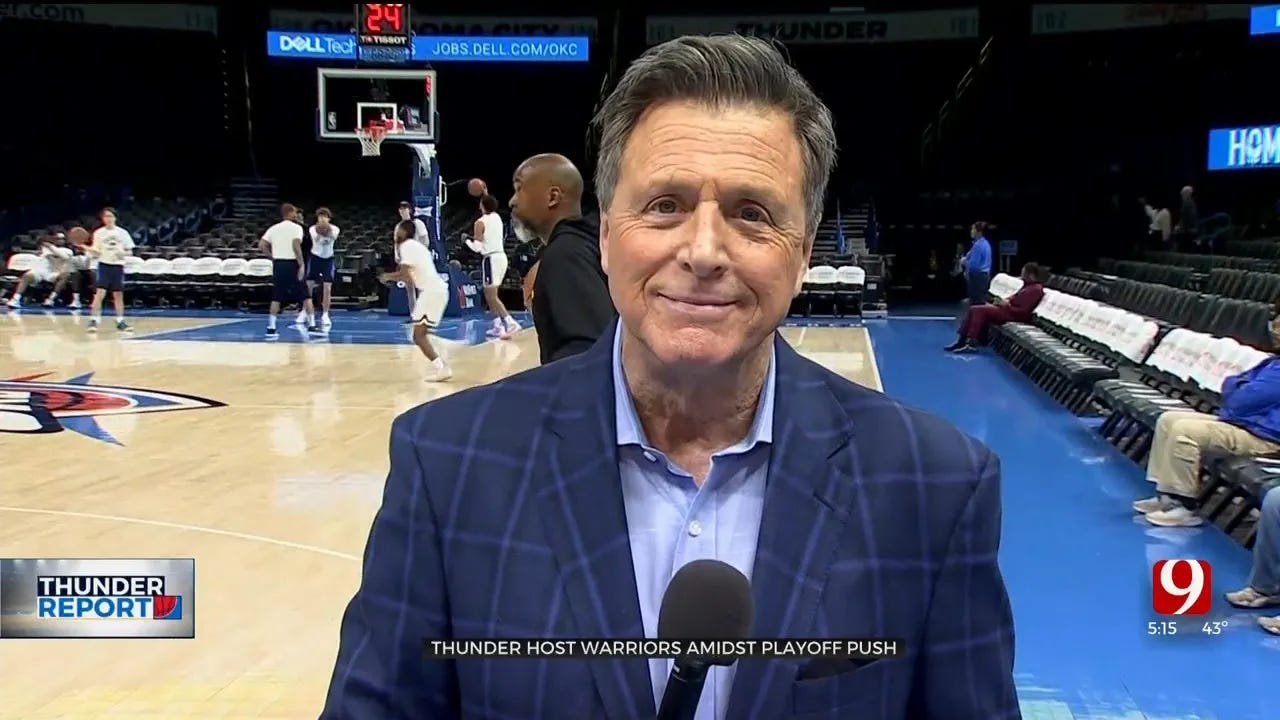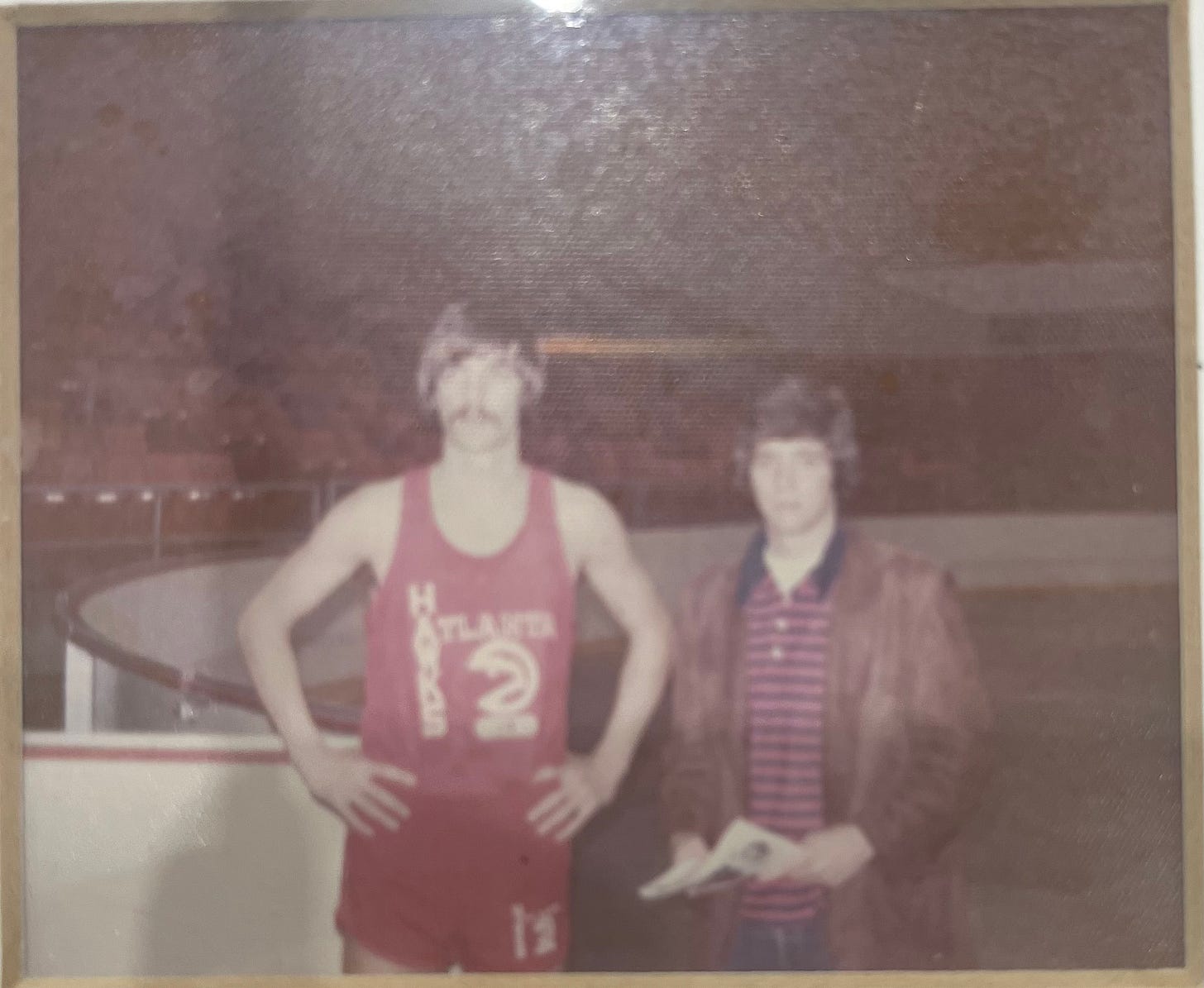Where to begin with Dean Blevins' getting out of the full-time sports media game?
Author’s note: The story below will also be running later this week in The Norman Transcript, and for that reason, there’s a particular time reference — “10 days” — that coincides with Thursday publication in the coming week. So that’s one thing. Here’s another:
I’ve known Dean Blevins since I began covering Sooner football in 1997. Before that, I knew him as an athlete, playing football at Oklahoma. Though he may be polarizing among media and fans, I’ve got nothing bad to say about him. To me, he’s always been friendly, always been generous and I’ve always appreciated it.
He let me know he’d be retiring about an hour before he announced it on channel 9 last week, and being a writer who maintains a voice in Norman’s daily newspaper, I decided he deserved the full treatment as an icon of the town, perhaps trailing only James Garner and Barry Switzer.
We talked for about 40 minutes and this is the story that conversation produced.
At the very least, I hope it makes clear Dean did not get to where he got to by accident.
He worked it as hard as he could for as long as he could.
He deserves the decision he’s made.
That Dean Blevins needs no introduction is a very good thing and do you know why?
Because 10 days after announcing he’ll be leaving the full-time sports media game after 41 years in it, 28 of them at KWTV-9 in Oklahoma City, Blevins remains difficult to introduce.
Do you begin with his professional resumé, one that includes a bunch of years as KOCO-5’s sports guy, followed by many more years as the guy at channel 9?
Of course, room must be left to mention the hundreds — thousands? — of coaches’ shows he’s hosted, the college football he’s analyzed on behalf of ABC, CBS and ESPN, the radio he’s done and will continue doing post-retirement for a segment or two each day; not to mention his work as a pitch man for car dealerships and, who could forget, Interurban restaurants, alongside his late and great friend Robert Ross; not to leave out the time he moonlighted as a sportswriter, penning Dallas Cowboy columns for “The Bayless Fax”; or even the first event he and I both covered, though we didn’t properly meet until later, the 1994 Class 5A state title game at Oklahoma State’s Lewis Field between Woodward and Broken Bow, a triple-overtime classic claimed by a Boomer goal-line stand, called for statewide television by Blevins and Mick Cornett, before the latter set his sights on becoming Oklahoma City’s mayor.
You could begin there.
It’s a big part of the story.
“I remember thinking no one was going to outwork me,” Blevins said. “My thought was, I’m in the time of my life’— it was about between the time I was 30 and 50 — and I said, ‘I’m in the prime of my life, I’m going to give it everything I have … I’m just going to dive right into it,’ because otherwise I’d be watching it anyway.
“I was going to do everything I could, from hiring a speech coach to learning how to speed read, to tons and tons of things, that work behind the scenes.”
So he did it.
At one time, Blevins’ work day began at 7 a.m., talking sports with Rick and Brad, the morning voices then and now of Rock 100.5 The KATT in Oklahoma City.
After that, he might spend his mornings selling advertising to friends and contacts, writing, producing and recording ads he narrated.
In the afternoon, he was back on the radio, talking sports, going deeper and longer than his few minutes on the KATT.
He was the sports guy, too, of course, on the 6 p.m. and 10 p.m. news, a full-time job its ownself.
During college football season, he’d fly out Wednesday for his next game, attending production meetings and preparing for a Saturday contest, one he might spend working with play-by-play men like Brent Musberger, Keith Jackson and others, offering sideline reporting or analysis from the booth.
When Barry Switzer found himself coach of the Dallas Cowboys, Blevins was all over that, too, hosting Switzer’s coach’s’ show, becoming a household-name media fixture in two markets, the Dallas-Fort Worth Metroplex and Oklahoma City, too.
“My heart raced from the time I started [in the morning] until the time I went to sleep,” Blevins said.
Once, when the Cowboys took him to Los Angeles, he found himself in the circle of James Caan, the actor — The Godfather, Misery, Rollerball; you know him — who badly wanted to meet Switzer.
Blevins set it up and he and Caan became good friends until Caan’s death in July of 2022.
You can’t make it up.
“That’s one of the things that happens,” said Blevins, still with a certain amount of wonder in his voice that it happened.
Absolutely, you could begin there.
• • •
There’s another option.
Not just the career to which he dedicated himself, but how he dedicated himself to it, the way he thought it should be done and the way he demanded he be allowed to do it upon landing at KOCO in 1988.
Before Blevins, critical analysis was not a thing among local sports anchors in the Oklahoma City market.
That wasn’t the way Jerry Park did it at KOCO, or Bob Barry Sr. at KTVY or John Snyder at KWTV in the 1970s and beyond.
Blevins, though, had a background in it, first putting himself on the air alongside Bill Land on a statewide call-in cable show out of Tulsa called “Sportscene.”
“We were pushing the envelope all the time with new ideas, new things, hard questions, subscribing to 14 newspapers that Bill and I would look through every day, just trying to absorb all this information,” Blevins said. “So you become opinionated … and that’s the way I wanted it.
“So, when I was interviewed by channel 5 and they said, ‘Here, we want you to take this job,’ I said, ‘Man, I will do that, but I need to do it from a different perspective.’”
Channel 5 agreed and would have been crazy not to given Blevins’ athletic pedigree: two-sport high school superstar, recruited to play both quarterback by Switzer and point guard by North Carolina’s Dean Smith, who after a year of playing both hoops and football at Oklahoma, settled on quarterbacking and was a big part of the day Sooner Magic was born, throwing the ball to receiver Steve Rhodes, who lateraled to Elvis Peacock, who made it all the way to the 2-yard line at Nebraska’s Memorial Stadium on Nov. 26, 1976, and then scoring the game-winning touchdown on the next play.
How could KOCO not let a sports anchor with that kind of background and expertise not speak his mind?
Still, as big a no-brainer it appears in retrospect, it was not the norm and still wasn’t until Blevins had been doing it for quite some time, breaking a whole lot of sports news along the way.
He possessed the knowledge, experience, work ethic and gravity to chart his own course, not setting out to be a pioneer in the field but becoming one nonetheless.
So that’s a good one.
You could start there, too.
• • •
Or maybe not.
There’s yet another way to introduce Blevins and it begins at 329 Woodside Drive, Norman, not long after Pete Maravich became his hero and obsession in ways you cannot imagine.
Maravich remains the leading scorer in NCAA men’s college basketball history, netting 3,667 points over three LSU seasons — freshman did not play varsity those days — without aid of a 3-point shot.
Beyond that, Maravich had style, as famous for the floppy socks billowing out of his high-tops as he was for crazy passes nobody saw coming but the teammates who played with him every day practice.
Over 83 collegiate games, Maravich averaged 44.2 points, and though his professional career eventually brought him back to Louisiana as a member of the New Orleans Jazz, it began in Atlanta, where he spent four seasons as a Hawk after being taken No. 3 overall in the 1970 NBA draft.
“I started going to Atlanta on spring break, [each year] I’d take a different friend, and we would go sneak into the Atlanta Hawks basketball practices,” Blevins said. “And the first time I did that, I went down to the floor after practice.”
He met Maravich.
He made the same type of trip for six years, whether that meant heading to New Orleans after Maravich joined the Jazz, or to Kansas City or Omaha, if Maravich was on the road to play the old Kings, a team simultaneously claimed by two cities in two different states between 1972 and 1975.
You can look it up.
“I remember this because I went to Maravich’s hotel room,” Blevins said, “and by this time he had taken all these pictures with me and seen me so often, he knew me, and he knew me as a pest.”
Yet, before Blevins hit the road to meet his idol, if he could get his car situated just right in the family driveway, he could bring in Atlanta superstation WSB-AM 750 and listen to the great Skip Caray call Maravich and the Hawks.
“I sat in that car with the notepad that I kept forever,” he said. “Kept field goals, field goals attempted, free throws made, free throws attempted, assists, turnovers. I kept all of those.”
Talking about it 50-plus years later, Blevins recalled how the broadcast might begin if, say, the Hawks were playing host to the Knicks:
“Hello again, everybody, this is Skip Caray from the Omni in Atlanta, where ‘Pistol’ Pete Maravich will take on Clyde Frazier of the New New York Knickerbockers.”
A light turned on.
“That’s where it all began.” He said. “You think about the hours spent, devoted, just sitting in that car.”
Through his fascination with one athlete, listening to game after game after game on a car radio outside his Norman home, charting stats, writing it all down, night after night, he was on his way.
He might not have known it, but he was already putting in the work that one day would lead to a 41-year career on Oklahoma’s airwaves, a career he’ll exit at the end of June.
You could start there, too.
Take your pick.




Well done. Good piece.
Clay: Have you decided to lay off moser as the Sooner's men's basketball squad stumbles its way into the NIT? Well, that's IF the powers that be see fit to allow the talented but coachless team to enter post-season play.